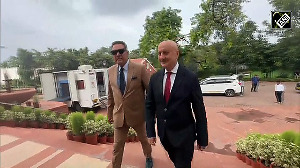Cracking the Graduate Management Admissions Test (GMAT) might seem like a mountain climb, but is the mountain really that high? Not really!

You might be frantically searching for tips on Google Search and racking your brains about how to get to a 700+ score.
Yes, GMAT is a demanding climb, but reaching the peak is definitely something that can be accomplished.
The exam comprises four sections -- Analytical Writing Assessment (30 minutes), Integrated Reasoning (30 minutes), Quantitative (75 minutes), and Verbal (75 minutes).
These handy tips from GMAT experts on how to solve different types of questions, will help you focus better and score high.
1. Problem Solving (PS): Quantitative section
You might be able to solve some problems by working backwards from the answer choices to the problem.
Remember that the task is not to solve the question but get to the correct answer.
At the same time, make sure your fundamentals are strong.
The GMAT Quant is not a "bag of tricks" -- you still need to know formulae in arithmetic, algebra, and geometry. There is no escaping this, so invest time in building your base.
Here is a pro tip: Start with a "ballpark" estimate for solutions with numerical values.
Try to roughly estimate the size of the number which helps you eliminate wrong answer choices.
2. Data Sufficiency (DS): Quantitative section
It is important that you memorise the five answer choices. They are the same for each and every Data Sufficiency question. So you save valuable time on the GMAT.
These questions are designed to test your ability to think conceptually.
If you find yourself doing a lot of number crunching, you're doing something wrong.
Start asking yourself 'what will answer the question" -- and stop asking "what is the answer to the question".
This section lends itself perfectly to using the process of elimination. For example, if Statement 1 answers the question then the answer can be either A or D.
3. Sentence Correction (SC): Verbal section
The GMAT SC is not a test of knowledge. So don't worry about complex grammar terms.
It is a test of applying that knowledge in proper business writing. So you just need to apply logic to ensure the correct answer makes perfect sense.
A common error made by test takers is relying too much on their "ear".
GMAT test setters know this fact and hence try to confuse you by creating an option that "sounds right" but is either logically or grammatically flawed.
Remember that SC is about eliminating wrong answer choices, not about selecting the right answer. So stop looking for the right option, instead look for possible errors in the wrong answer options.
4. Critical Reasoning (CR): Verbal section
Read the question before you read the argument. This will tell you what to expect when you are reading the stimulus.
Having a focus on what to look for will greatly improve your efficiency in reading what could be very dense and complex information.
Know your approach to different question types such as "find the assumption", "resolve the paradox" like the back of your hand.
This way, you can jump into solving the question much more quickly and you won't waste any time second-guessing what a question is asking you to do.
Make sure you are aware of the standard GMAT traps. If it rains then the roads will be wet, but if the roads are wet -- it doesn't mean it has rained.
A lot of questions will test your ability to discriminate between what is "common sense-sically" correct and what is "logically" correct.
5. Reading Comprehension (RC): Verbal section
Consider each and every answer choice.
A lot of times, students make the mistake of picking something that they have seen in the passage, but GMAT will try to trick you by rephrasing the correct answer options to include words you might not expect.
GMAT RC is all about jugglery of words. So there would be a difference between "discussing the problem" and "describing the problem". The biggest challenge on GMAT RC is sifting through voluminous data to make sense of what is required to answer that specific question.
GMAT RC can really be demanding in terms of mental stamina.
It is important that you keep your practice sessions long enough, and try to take the practice tests under exam conditions, to ensure your brain is able to prepare for comprehending dense passage while under pressure.
6. Analytical Writing Assessment (AWA)
The topics tested on AWA are given on the GMAT website.
Having a templatised approach will ensure you do not end up exhausting yourself during the test.
Be specific and pick examples that are relevant to support the argument you're making.
Using examples from common life as an analogy to the problem at hand is taken as a sign of good argument structure.
Do not use complex words just for the sake of using them.
The AWA is not designed to judge your vocabulary. Don't create the impression that you used big words to mask weaknesses in your analysis.
7. Integrated Reasoning (IR)
Treat Integrated Reasoning like an open-book test. It comprises 12 questions.
The data you need to solve IR questions lie on the various screens; you just have to know where to look and which table, chart or part of the passage provides the relevant information you'll need for the correct answer.
Pause to read all the labels. Unlike RC, skimming will never work here.
Mentally categorise each graph, chart and table so you know how to relate the variables found in each table or chart.
Here is another expert tip: Check out the units. On the GMAT, you may be expected to take special care to note the units (mph, m/sec, etc..) and even convert them, if required.
General Practice Strategies
Don't take practice tests too often.
Take one to begin your preparation so that you have an idea of what to expect.
Take another three over the next 6 to 8 weeks of your prep. Towards the end, a maximum of one test per week will do.
Learn to simulate the Test Day. Take the test with the AWA and IR sections, at the same time of day that you've booked your test slot.
Don't eat or drink anything during the test; do it during the breaks and don't make those long either.
Analysis is the key to improvement.
Keep an error log that tells you WHY you made the mistake and not WHAT mistakes you made.
Ensure you practice from only official test preparation material, and analyse each and every question very well.
Knowing why an answer option is wrong, is as important as knowing why the correct option is correct.
Tips for GMAT Exam Day
There are two optional breaks and you should certainly take these to clear your mind and regain your mental stamina.
Ensure you drink enough fluids so you are hydrated, and eat something light but filling -- think idlis, so you can stay focussed for four hours.
Do not be stubborn with difficult questions. If you are unsure about what answer is correct, look for answers that you know are wrong, eliminate them, and make an educated guess.
Check the time periodically, but don't be clock-paranoid.
Manage time by keeping to a rhythm and figure out if you're ahead, behind or right on pace. If you're behind, adjust your tempo and move to the beat.
A big shout-out to all you GMAT takers out there because it sure isn't easy to crack this test!
So strap on your hook and get climbing till you reach the top! And if you need a guiding hand along the way, reach out to us; we'd be glad to help you!
Lead image used for representational purposes only. Image: videorevive/Pixabay.com
The author Arun Jagannathan is CEO and founder Crack Verbal, an admissions counselling and consulting services.











